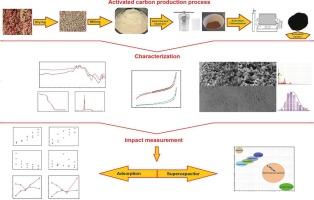Hydrochar-derived activated carbon from chenopodium botrys for dual applications in dye removal and energy storage
IF 5.1
3区 材料科学
Q2 MATERIALS SCIENCE, COATINGS & FILMS
引用次数: 0
Abstract
This study reports the synthesis of activated carbon from Chenopodium botrys biomass through two approaches: direct chemical activation (Cb-AC) and a two-step route involving hydrothermal pretreatment followed by chemical activation (Cb-HC-AC). Structural characterization confirmed that hydrothermal pretreatment introduced abundant oxygen functional groups and facilitated mesopore development. In methylene blue (MB) adsorption experiments, Cb-HC-AC exhibited a maximum capacity of 140.83 mg/g, significantly higher than that of Cb-AC (77.15 mg/g). Adsorption kinetics followed a pseudo-second-order model, while isotherm and thermodynamic analyses revealed that adsorption on Cb-HC-AC was endothermic and entropy-driven, in contrast to the exothermic behavior of Cb-AC. Furthermore, Cb-HC-AC demonstrated excellent electrochemical performance as a supercapacitor electrode, achieving a specific capacitance of 441 F/g at 0.2 A/g, 93 % retention after 5000 cycles, and an energy density of 16.94 Wh/kg. These results introduce C. botrys as a novel, sustainable precursor for multifunctional activated carbon and highlight the critical role of hydrothermal pretreatment followed by chemical activation in enhancing both adsorption and energy storage applications.

从chenopodium瓶中提取的氢衍生活性炭在染料去除和能量储存方面的双重应用
本研究报道了Chenopodium botrys生物质合成活性炭的两种途径:直接化学活化(Cb-AC)和水热预处理-化学活化(Cb-HC-AC)两步法。结构表征证实了水热预处理引入了丰富的氧官能团,促进了介孔的发育。在亚甲基蓝(MB)吸附实验中,Cb-HC-AC的最大吸附量为140.83 mg/g,显著高于Cb-AC的77.15 mg/g。吸附动力学遵循准二阶模型,等温线和热力学分析表明,与Cb-AC的放热行为相反,Cb-HC-AC的吸附是吸热和熵驱动的。此外,Cb-HC-AC作为超级电容器电极表现出优异的电化学性能,在0.2 a /g时达到441 F/g的比电容,循环5000次后保持率为93%,能量密度为16.94 Wh/kg。这些研究结果介绍了C. botrys作为一种新型的、可持续的多功能活性炭前体,并强调了水热预处理和化学活化在增强吸附和储能应用方面的关键作用。
本文章由计算机程序翻译,如有差异,请以英文原文为准。
求助全文
约1分钟内获得全文
求助全文
来源期刊

Diamond and Related Materials
工程技术-材料科学:综合
CiteScore
6.00
自引率
14.60%
发文量
702
审稿时长
2.1 months
期刊介绍:
DRM is a leading international journal that publishes new fundamental and applied research on all forms of diamond, the integration of diamond with other advanced materials and development of technologies exploiting diamond. The synthesis, characterization and processing of single crystal diamond, polycrystalline films, nanodiamond powders and heterostructures with other advanced materials are encouraged topics for technical and review articles. In addition to diamond, the journal publishes manuscripts on the synthesis, characterization and application of other related materials including diamond-like carbons, carbon nanotubes, graphene, and boron and carbon nitrides. Articles are sought on the chemical functionalization of diamond and related materials as well as their use in electrochemistry, energy storage and conversion, chemical and biological sensing, imaging, thermal management, photonic and quantum applications, electron emission and electronic devices.
The International Conference on Diamond and Carbon Materials has evolved into the largest and most well attended forum in the field of diamond, providing a forum to showcase the latest results in the science and technology of diamond and other carbon materials such as carbon nanotubes, graphene, and diamond-like carbon. Run annually in association with Diamond and Related Materials the conference provides junior and established researchers the opportunity to exchange the latest results ranging from fundamental physical and chemical concepts to applied research focusing on the next generation carbon-based devices.
 求助内容:
求助内容: 应助结果提醒方式:
应助结果提醒方式:


